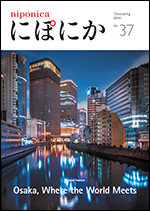
2025 NO.37
MenuOsaka, Where the World Meets

History of Osaka, A City Shaped by Encounters
For centuries, Osaka has flourished as a strategic nexus connecting the sea and land. The history of the city has been firmly shaped by the exchange of people and goods, as well as the intermingling of different cultures.

Utagawa Sadahide’s Naniwa Tenma Matsuri depicts the bustling Osaka waterfront during a festival in the Edo period. (Collection of Osaka Prefectural Nakanoshima Library)
Osaka has been a land of thriving exchange of people and goods for centuries. This created a new culture shaped by a bold mix of people and goods. Located on the shore of a calm bay and connected by rivers to such political centers like Kyoto and Nara, the city is also traversed by many roads leading in and out in all directions. As a long-standing critical transportation hub, Osaka has evolved into a place where various communities come together to create the foundations of new culture.
Osaka’s history as a crossroads of exchange began with Naniwatsu Port, which was established around the 5th century. As a gateway to the world, Naniwatsu Port served as a departure point for the diplomatic missions of the time. This thriving trading port welcomed many visitors from abroad and is said to have flourished as a central hub for global interaction. It was in the vicinity of Naniwatsu Port that Japan’s first state-built temple, Shitennoji, was constructed. Back then, as Osaka engaged with and gradually embraced the new worldview of Buddhism, the foundations of the city’s unique culture began to take shape.
It was much later, during the Edo period (1603–1868), that Osaka, the city of encounters, took another major step into its destiny. Toyotomi Hideyoshi, the feudal lord who finally unified all of Japan in the 16th century, had built Osaka Castle. However, the town surrounding the castle was destroyed in the war. In response, the Edo Shogunate gathered a group of merchants and artisans, relocating them to Osaka to build a commercial city with a system of waterways. The large number of bridges constructed here earned the moniker “the 808 Bridges of Naniwa,” and people enjoyed the scenery along the riverbanks by taking boat rides in all four seasons. At the same time, progress was made in developing sea routes from Osaka to regions across Japan. These routes connected not only Edo (present-day Tokyo) but also Hokkaido and other distant locations to Osaka, enhancing its role as a logistics hub known as “the nation’s kitchen.”
In the modern era, Osaka made significant advancements. As textile and other cottage industries developed, the city expanded, and its population grew to surpass Tokyo, making Osaka the largest city in Japan. Osaka was now a metropolis on the level of New York, London, Paris, and other major world cities, and prospered immensely as “Greater Osaka.” This was a time when modern urban culture, particularly ornate modern architecture, was in vogue. Many of the opulent buildings of those days still adorn Osaka today, leaving a valuable legacy that reflects the city’s growth and development at that time.
Starting in the 1930s, many of the waterways that had formed the backbone of Osaka had deteriorated due to poor water quality and the prevalence of land transportation. However, in the 1970s, steps were taken to improve the water quality of the rivers, and in 2001, efforts began to revive the city as “Aqua Metropolis Osaka.” In recent years, the promenades and parks built along the rivers, the illuminated bridges, and the riverside events have created a lively atmosphere that makes the most of the city’s waterfront locations. “Aqua Metropolis Osaka” is seeing a revival with a new story written by the throngs of people who come and go through Osaka today.






